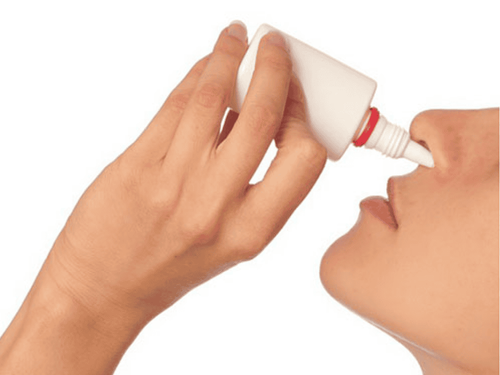This is an automatically translated article.
The article was professionally consulted with Specialist Doctor I Le Van Quang - Department of General Surgery - Vinmec Nha Trang International General HospitalDeviated nasal septum is a type of physical disorder affecting the nose area, the nasal septum will be crooked to one side, developing abnormally, making the patient susceptible to respiratory diseases such as rhinitis. , Sinusitis.
1. Signs of deviated nasal septum?
1.1 Nasal congestion Many people have a very mild deviated septum and cause no symptoms at all. However, the first symptom of a deviated septum is frequent, unilateral or bilateral nasal congestion.
This obstruction makes it difficult for the patient to breathe in one or both nostrils, even without rhinitis.
Nasal congestion is aggravated when the patient has a respiratory infection such as the common cold, flu or when the patient is allergic to respiratory agents...
1.2 Nosebleeds The surface of the nasal septum is very sensitive. fragile, is the concentration of many small blood vessels and is shallow, when the septum is crooked, the surface of the septum becomes dry, increasing the risk of nosebleeds.
1.3 Facial pain If the deviated septum is severe, causing obstruction in one side of the nose, the patient may experience pain or a feeling of heaviness on the side of the face and on the same side of the nose.
1.4 Noisy breathing during sleep When one nostril is narrowed, the air passing through that narrow nasal tube will cause noisy breathing, especially during sleep, this phenomenon is more common in children than in adults .
1.5 Always lie on one side when sleeping Because one side of the nose is narrow due to a deviated septum, some people tend to sleep on their side only to make it easier to breathe through their nose.
1.6 Nasal cycle Nasal cycle is the rotation of nasal congestion from one side to the other, when one side of the nose is blocked due to blood stasis in the nasal tufts, the other side is open. This phenomenon is normal and often we do not realize it, but if the patient can clearly feel the nose cycle, it is an abnormal phenomenon, possibly due to infection or deviated septum. compartment.

Vẹo vách ngăn làm gia tăng nguy cơ chảy máu mũi
2. What causes deviated nasal septum?
There are many possible causes of a deviated septum. Among them, the main causes can be mentioned as:
2.1 Congenital septum deformity In some cases, deviated nasal septum occurs during fetal development and we can recognize it immediately after birth. born.
2.2 Injury to the nose A deviated septum can also be the result of an injury to the nose that causes the septum to deviate to one side. For young children it is the trauma of labor. In older children and adults, all accidents, from daily life, traffic accidents or violence, as long as there is a mechanical impact on the face and nose, can cause deviated septum. The normal aging process can also change the nasal structure and deviate the nasal septum over time.
2.3 Chronic inflammation of the nose Allergic rhinitis, rhinosinusitis ... can also change the structure of the nose, the frequent rubbing and wiping of the nose due to rhinitis can also change the structure of the septum. prevent deviated nasal septum.
As mentioned, some people are born with a deviated septum at birth, while some people are the result of external trauma. As a result, highly interactive sports players or drivers without seat belts are more prone to deviated septum due to trauma to the nose.
3. What complications can a deviated nasal septum lead to?

Vẹo vách ngăn mũi có thể gây nghẹt mũi một bên hay hai bên kéo dài mà không đáp ứng với thuốc điều trị
In severe cases of deviated septum, causing nasal obstruction, this can lead to the following complications:
Dry mouth due to nasal congestion must breathe through the mouth for a long time Feeling of heaviness, congestion in the nasal cavity Disorders sleep (snoring, sleep apnea) Nosebleeds Recurrent nasal infections. In addition to the above unpleasant complications, patients need to see a doctor if they have one of the following conditions:
Persistent nasal congestion on one or both sides that does not respond to medications Frequent nosebleeds Nasal infections Prolonged or recurrent sinus congestion Nasal congestion greatly affects the quality of life.
4. Diagnostic and Interventional Measures
When the nasal septum is severe, the doctor will conduct a nasal endoscopy to assess the degree and type of the deviated septum as well as to diagnose other associated disorders, from which reasonable intervention measures will be taken. patient.
4.1 CT scan CT-scanner can also be performed to further investigate the deformed septum, picture deviated nasal septum as well as the sinus system, especially before surgical intervention is indicated. deviated nasal septum.
Many people have deviated nasal septum without intervention. However, there are some cases of severe curvature, causing complications, and surgery to correct the septum is indicated, making the septum become straight again.
In addition to surgical treatment for severe cases of deviated nasal septum, drug measures to relieve symptoms of discomfort for patients include:
4.2 Anti-congestive drugs These medications relieve nasal congestion. Congestion caused by swelling of the soft tissues in the nose, making it easier for air to flow in and out of both sides of the nose. Nasal decongestants are available in spray and oral tablet form, both of which are equally effective.
However, decongestant nasal sprays, if used for a long time, lead to drug dependence and rebound reactions (ie, nasal congestion that returns and worsens initially after discontinuation of the drug). On the other hand, oral decongestants can cause an increase in heart rate and blood pressure. Both drugs should not be given to young children.
Corticosteroid nasal sprays help fight inflammation and reduce congestion in the nose. But it usually takes 1-3 weeks for the drug to take full effect, so it's important to follow your doctor's instructions to avoid the side effects of this class of drugs.
4.3 Anti-allergic drugs People with deviated septum are more likely to have allergic rhinitis, so anti-allergic drugs are also useful in controlling these nasal symptoms such as: itchy, stuffy, runny nose. However, some anti-allergic drugs can make patients drowsy, adversely affecting those who need alertness, such as when studying or driving.
Currently at Vinmec International General Hospital, the problem of deviated nasal septum is solved by the method of endoscopic orthopedic nasal septum surgery. Surgery is indicated for all patients with deformed septum causing obstruction of nasal ventilation, obstructing nasal sinus drainage, deviated septum causing irritation to headache, and obstructing the passage of nasal passages. endoscopic sinus surgery and abnormal cases causing sinusitis.
Please dial HOTLINE for more information or register for an appointment HERE. Download MyVinmec app to make appointments faster and to manage your bookings easily.













